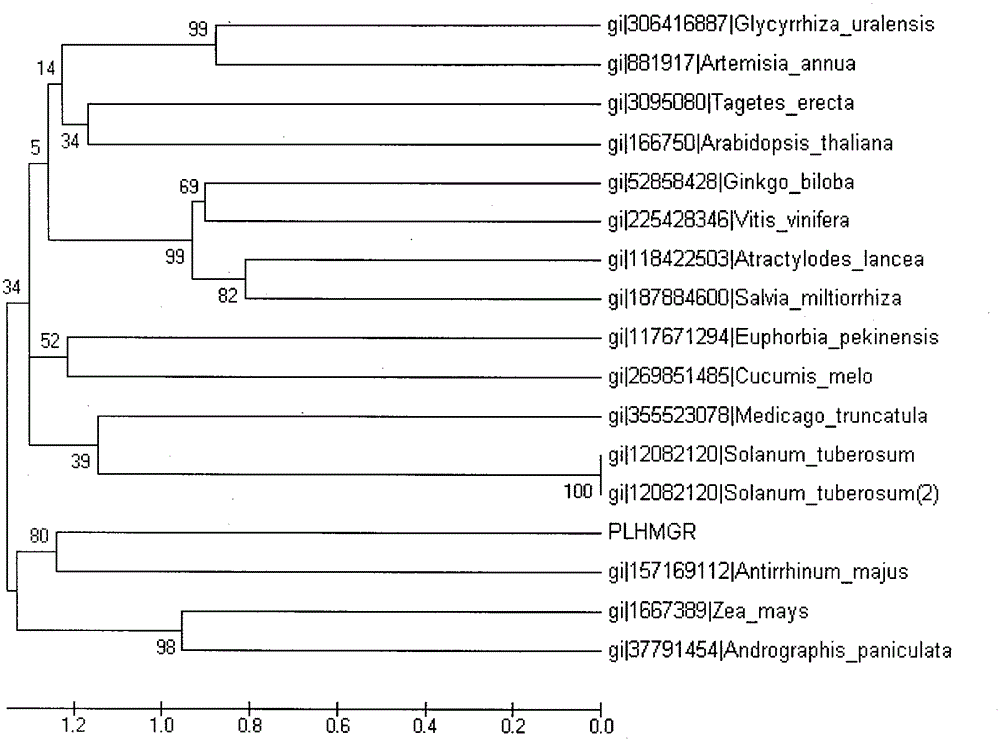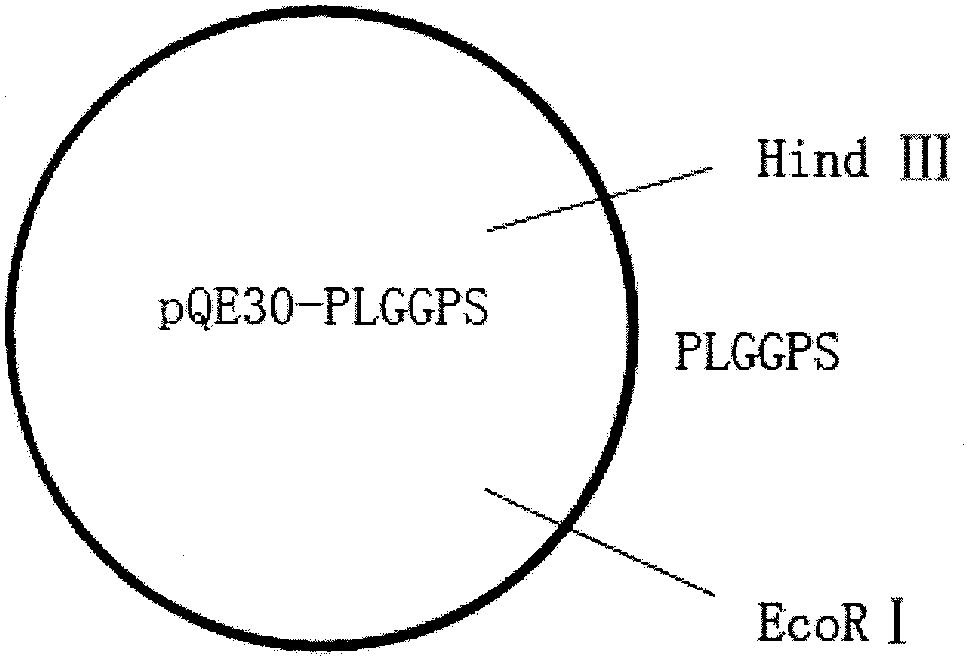Peony geranyl geranyl pyrophosphate synthase (plggps) gene and its encoded products and applications
A technology of geranyl pyrophosphate and enzyme gene, applied in application, genetic engineering, plant genetic improvement, etc., to achieve the effect of increasing the content of terpenoids
- Summary
- Abstract
- Description
- Claims
- Application Information
AI Technical Summary
Problems solved by technology
Method used
Image
Examples
Embodiment 1
[0018] Embodiment 1, the construction of peony cDNA library
[0019] 1. Isolation and detection of peony total RNA
[0020] Take 2 g of the root of Paeonia lactiflora, quickly grind it into powder with liquid nitrogen in a mortar, and quickly transfer it to 10 mL of extraction buffer (CTAB (W / V) 2%, Tris-HCl (pH 8. 0) 100mmol·L -1 , EDTA25mmol·L -1 , NaCl2.0mol L -1 , PVP402%, spermidine 0.5g / L, mercaptoethanol 2%), fully shake and mix; extract twice with equal volume of chloroform, and centrifuge at 7500g for 15 minutes. Add 1 / 4 volume of 10MLiCl to the supernatant, mix well, and place it at 4°C to precipitate overnight; centrifuge at 7500g for 20 minutes, and use 500 μL SSTE (SDS0.5%, NaCl1mol L -1 , Tris-HCl (pH8.0) 10mmol L -1 , EDTA1mmol·L -1 , dissolved at 65°C for 5 minutes. Extract with an equal volume of chloroform, centrifuge at 13,000g for 5 minutes; add 2 times the volume of absolute ethanol to the supernatant, and store at -70°C for 2 hours; centrifuge at 1...
Embodiment 2
[0023] Example 2: Cloning of Paeoniae officinalis-related genes
[0024] Randomly pick 5000 single clones for colony PCR identification. Take an appropriate amount of PCR thin-walled tubes, place them on ice, and add 17.3ul of sterilized water to each tube. Use a sterilized 10ul small tip to pick up the monoclonal white spot into sterilized water, shake and mix. Add in sequence: Taqbuffer 2.5μL, MgCl 2 (25mM) 1.8μL, dNTP (2.5mM) 1μL, M13+ primer (10pmol) 1μL, M13-primer (10pmol) 1μL, Taq enzyme 0.4μL. The PCR reaction conditions were 5 minutes of pre-denaturation at 94°C, 40 seconds at 94°C, 40 seconds at 54°C, 4 minutes at 72°C, 35 cycles of extension at 72°C for 10 minutes, and storage at 4°C. After the PCR reaction enters 4°C, remove the PCR thin-walled tube, take 7ul of PCR product and add 3ul of bromofinland for agarose gel electrophoresis, take a picture half an hour later, observe the gel map, and roughly identify the size of the insert fragment and small fragments a...
Embodiment 3
[0025] Embodiment 3, the bioinformatics analysis of PLGGPS gene
[0026] The full-length cDNA of the peony geranylgeranyl pyrophosphate synthase gene involved in the present invention is 1110 bp in length, and the detailed sequence is shown in sequence 1 in the sequence list, wherein the open reading frame is located at 1-1110 bp. The full-length cDNA sequence of Peony was searched for nucleotide homology in Non-redundantGenBank+EMBL+DDBJ+PDB and Non-redundantGenBankCDStranslation+PDB+Swissprot+Superdate+PIR databases using BLAST program. The gene has high homology with GGPS in other species at the amino acid level, and has a typical Geranylgeranylpyrophosphatesynthase domain. Such as figure 1 .
PUM
 Login to View More
Login to View More Abstract
Description
Claims
Application Information
 Login to View More
Login to View More - Generate Ideas
- Intellectual Property
- Life Sciences
- Materials
- Tech Scout
- Unparalleled Data Quality
- Higher Quality Content
- 60% Fewer Hallucinations
Browse by: Latest US Patents, China's latest patents, Technical Efficacy Thesaurus, Application Domain, Technology Topic, Popular Technical Reports.
© 2025 PatSnap. All rights reserved.Legal|Privacy policy|Modern Slavery Act Transparency Statement|Sitemap|About US| Contact US: help@patsnap.com



